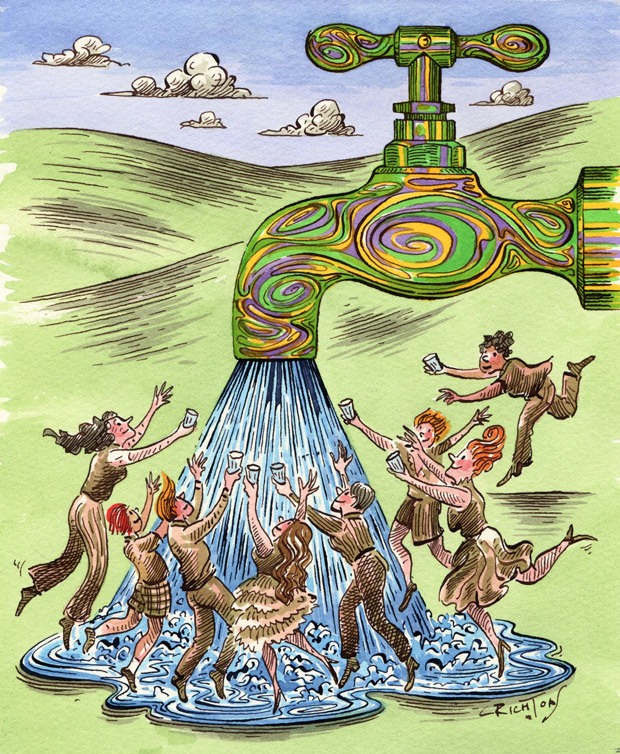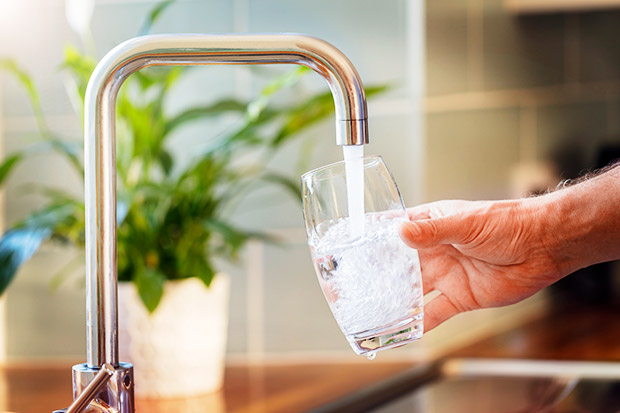Dr Roderick Mulgan: Why bottled water makes as much sense as selling oxygen to people surrounded by air

Water, water everywhere and far too much to drink…
Words: Dr Roderick Mulgan Illustration: Anna Crichton
Time was, people needed water in bottles. Water was a significant source of diseases such as cholera and typhoid, and getting it in a bottle from a pure underground source helped people stay safe. It could even be good for you, or so sellers claimed.
Bathing in artesian springs was a popular health pursuit in the 19th century, and exotic mineral drinking water from caverns measureless to man was marketed on the same vibe. If soaking in it was a tune-up, why not drink some?
Perrier was the first major brand and was particularly popular for coming out of the ground with natural fizz. An amateur chemist, Johann Schweppe, helped by determining how to put the fizz in artificially, and the lemonade bearing his name has been part of the commercial landscape ever since.
But at the start of the 20th century, chlorination was invented. The simple step of purifying drinking water with chlorine is one of the most significant advances in public health of all time. A cheap and straightforward process has given us safe water on a large scale ever since, to the point where nobody questions it. We can now drink water out of taps. It wasn’t always so, but our age has safe reticulated water, and nothing stops us from relying on it.
So chlorination stopped the bottled water party, and things stayed that way for decades. But in the 1970s, the concept started to catch on again in Britain and the United States as part of high-end dining. Big advertising campaigns did their bit, with Perrier the head of the pack as a fashionable mimic of champagne. As with many things, free markets and large-scale production spread the idea to the masses over time, and eventually, chic green glass gave way to polyethene.

We now live in times when it is part of life to top oneself up from a bottle all day. The cost is vastly more than that of the same product from the kitchen sink, but few see that as a barrier. It makes as much sense as selling oxygen to people surrounded by air, but it is hugely profitable.
Freud only knows why sucking on a blue nipple is so popular, but there are hundreds of brands, generally owned by top-end food players such as Nestlé and Coca-Cola, and the industry is worth billions. Unfortunately, it is an affectation with considerable downsides, and none of the popular justifications adds up.
The first is hydration. Stay alert by keeping your blood pumping and all your bits moist. Or so the theory goes. Specialized hydration is fine if you are doing a marathon along a desert road. It is less fine if you are going about your daily business, even if that includes a gym workout. By all means, drink some water but don’t assume it has to be excessive and ongoing. You will not dry out and faint if you rely on the occasional glass from a tap.
The second is flushing out impurities. Your kidneys get on with things just fine without excess water being sent down to help them along. Your entire blood volume of about five litres is filtered twice an hour, which means your kidneys between them process 200 litres in a day. Another 500ml from a bottle of water, even several of them, makes no difference.
The third is the idea, harking back to the 19th-century roots of the practice, that water can be extraordinary — especially pure, especially mineral-rich, especially healthful. Branding evokes mountain peaks and bubbling springs even when the bottle was filled from the town supply where the factory is based, which most of them are.
As long as the water is clean — as modern tap water is — there is nothing additionally healthful it can deliver. Water is not nutrition. Bottled water does not even taste different when blind testing conditions are imposed. This might mean the whole thing is a polite
scam, but there is a sinister side.
Bottled water takes oil. Oil to make the polyethene bottles, oil to pump water into them, oil for the shrink wrap around the pallets, oil to transport them to the shop, oil to keep them chilled until it suits you to buy one. One rule of thumb often quoted is that the oil expended to bring a bottle of water to you is the same as a quarter of the bottle’s volume.
Oil is one thing when there isn’t much choice — like getting to work. It is quite another for a product that confers no value over the limitless water you can get from the regular supply.
Then when you have finished drinking, the rubbish cycle starts. Landfills and floating dumps in the ocean are heaving with empty water bottles. Barring the few that get recycled, every bottle you have drunk from is out there somewhere. They take centuries to decompose, so some natural reservoir has to accommodate them in the meantime. Many such reservoirs are a hazard to the natural world, such as the ones in ocean gyres.
Bottled water doesn’t even seem to dent sales of the sugary and processed options. Fizzy soft drinks continue to sell perfectly well, often from the same chiller cabinet and often owned by the same companies. Fizzy drinks are empty calories of sugar with acid (it is acid that tickles your taste buds), and anything that competes with them could be a community good, but water doesn’t seem to do it.
The vast quantity of water diverted for bottling is also politically controversial when it is taken from underground. Many water-bottling operations fill up from their own bore and often pay very little; all that most jurisdictions require is resource consent. There are legitimate questions about whether this makes the best use of a finite resource.
Water is not necessarily replenished as quickly as bore tappers can pump it out, and delicate geological balances get disturbed. Land sinks and wetlands dry up, and saltwater percolates into the gap. Some deep water has been there so long it is called “fossil water”, like oil. Nothing is going to replace it anytime soon.
Even more vitally, water for bottling is no longer there for people or crops. Year after year, the world has more people to feed, all the while as things get warmer. There might be better uses in decades to come for aquifers than the convenience of a disposable bottle.
So keep up your fluid intake, by all means. The nearest tap is more than good enough.
Support healthy ageing, sleep and immunity with LifeGuard, a series of science-backed supplements formulated by Dr Roderick Mulgan. Each formula uses key plant extracts and micronutrients to support your wellbeing. Learn more here.
Love this story? Subscribe now!
 This article first appeared in NZ Life & Leisure Magazine.
This article first appeared in NZ Life & Leisure Magazine.
